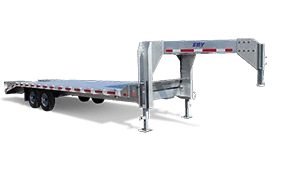Give your customers more buying power today!
Give your customers more buying power today!

Proper weight distribution is crucial for ensuring the safety and stability of any trailer, and gooseneck trailers are no exception. These versatile trailers, with their unique gooseneck hitch, offer several advantages when it comes to carrying heavy loads and transporting various cargo. However, understanding where to place the weight on a gooseneck trailer is essential for achieving optimal performance and preventing potential hazards. In this blog post, we’ll delve into the importance of weight distribution on gooseneck trailers and share key considerations to help you make informed decisions for your towing needs.
Before delving into weight distribution, let’s grasp the significance of the gooseneck hitch itself. Positioned over the towing vehicle’s rear axle, this hitch design offers enhanced stability and control during towing. The placement of the hitch affects how weight is distributed between the trailer’s axles and the towing vehicle, ultimately impacting the overall handling and safety on the road.
When loading a gooseneck trailer, it is generally recommended to place the heaviest items over or slightly ahead of the trailer’s axles. This placement ensures that a significant portion of the weight rests on the towing vehicle’s rear axle, promoting better balance and stability. The goal is to prevent excessive weight from being borne by the front of the trailer, which could lead to poor handling and sway during travel.
Every gooseneck trailer has a Gross Axle Weight Rating (GAWR), indicating the maximum weight each axle can support safely. Distributing the weight in such a way that it stays within the GAWR ensures that the trailer operates within its designed capacity, reducing the risk of overloading and potential damage to the axles.
The tongue weight refers to the downward force exerted on the gooseneck hitch by the trailer. It is essential to maintain an appropriate tongue weight, typically between 10% to 15% of the trailer’s total weight. Too little tongue weight can cause instability, while excessive tongue weight can overload the rear axle of the towing vehicle.
In addition to the overall weight distribution, maintaining a balanced cargo load is essential for safe towing. Ensure that items are evenly distributed on both sides of the trailer to prevent unnecessary strain on one side. Additionally, secure the cargo properly to minimize movement and shifting during transit, which could lead to dangerous weight imbalances.

Weight distribution is not a one-time task. It is essential to regularly inspect and adjust the load as needed, especially when hauling different types of cargo or altering the configuration of the trailer. Regular checks help you maintain a safe and stable towing experience.
Proper weight distribution is fundamental to the safe operation of gooseneck trailers. Placing the weight correctly over the axles, ensuring an appropriate tongue weight, and adhering to the GAWR are key considerations for optimizing the trailer’s performance. Remember to balance and secure the cargo properly and make regular checks to ensure a smooth and secure towing experience. By understanding the nuances of weight distribution on a gooseneck trailer, you can confidently tackle various hauling tasks while prioritizing safety and stability on the road.
Ready to take your heavy hauling and transportation to the next level? Look no further than C3 Rentals for top-notch gooseneck trailer rentals! Experience enhanced stability, increased weight capacity, and versatile cargo-hauling capabilities. Contact us now and unlock the power of gooseneck trailers for your towing needs!